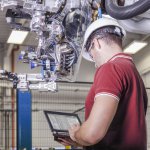
Scania’s team is exploring how digital twins can help them. Source: Shutterstock
Scania delves deeper into data to build intelligent digital twins
DIGITAL TWINS have been taking large enterprises by storm this year.
Built with a combination of technologies such as the internet of things (IoT), big data analytics, artificial intelligence (AI), and data visualization, digital twins help business leaders see data, customers, and their operations in a new light.
IDC recently predicted the rapid growth of interest in the concept among manufacturers.
“Digital twins have become one of the hottest topics in manufacturing today because of their promise to improve innovation and design, visually enhance collaboration, and enable ongoing operation of connected products and assets — all in a fast-paced, digitally transforming, competitive environment,” IDC said.
Most recently, Scania — the trucking giant — said in a blogpost that it has been exploring the use of digital twins in its business and expects to use the technology to help with predictive maintenance of its vehicles as well as operational facilities.
“We know that the future lies in combining and integrating information, which will be essential for developing better transport and logistics ecosystems. Our vehicles are already connected, and we need to achieve the same penetration in our manufacturing processes,” explained Scania IT Integration Servies Head Stefan Telhammar.
Data integration is the first step
In order to get started with digital twins, Scania started working on developing a cutting-edge data integration tool two years ago.
“We started small and came up with this technology, which has the advantage of collecting data in one format. That’s really the beauty of it all,” said Scania IT Integration Servies Solutions Architect Tanuja Gupta.
Tech Wire Asia‘s previous conversations with subject matter experts have revealed that getting the data in order and building and managing the data platform is the first step to using AI, and by extension, digital twins.
At Scania, systems collect data from all sorts of sources. The company actually doubles the data it collects every two years.
“All of this information is invaluable when analyzing performance and quality in designing even better vehicles, but it falls short when assessing performance in real-time. Scania’s response to that problem is to adopt cutting-edge data integration technology,” said Scania’s blogpost.
When the data is integrated, it’ll bring the enterprise-wide digital twin to life, making all sorts of use cases possible — including predictive maintenance, which is currently the focus of the team at Scania.
The company is already carrying out small trials and expects the first applications to be ready by 2021.
“These are early phases, but we’ve started monitoring a CNC cutting machine in production to determine wear and performance. There’s lots more to come,” expalined Gupta.
Digital twins will bring great value
“The starting points for using digital twins of product and assets will differ by company size, industry, and need,” said IDC Manufacturing Insights Product Innovation Strategies Program Director Jeff Hojlo,
“But the value derived by all manufacturers will be similar – clarity of communication, rapid collaboration, holistic visibility, accurate and efficient response to demand, monetization of IoT data, predictive and proactive services, and closer collaboration with customers.”
Recently, companies such as DHL and Tetra Pak have announced that they’ve invested in building digital twins as well, following in the footsteps of pioneers such as GE and Rolls Royce.
Whilst going the digital twins route seems to be in vogue, companies that want to make the most of their investment in terms of time and money need to make sure that they have reached a certain level of digital maturity before they take on such a project.
Like Scania, other companies exploring the advantages of digital twins should set out to build a robust, integrated data platform first, and then look at deploying a combination of emerging technologies to leverage that data in real-time — and charge ahead with digital transformation.
READ MORE
- Aviation giant Airbus turns to chatbots to engage top talent
- In the digital economy, MoneyGram focuses on getting the basics right
- How FedEx uses technology to delight customers in the digital era
- FedEx Express/Ground collaboration will improve last-mile delivery
- Growth is fabulous: Why Foodpanda’s app and team are growing rapidly




